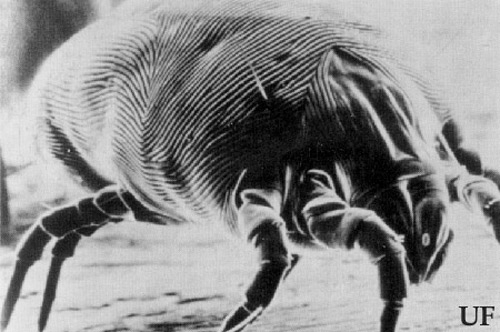I've noticed as I get older my Christmas wish list gets less interesting and more practical. I have to work harder now to think of fun stuff. Instead I end up with great ideas like silverware. I know I'm not alone.
So what do you get that special someone who insists on a practical gift?
As I was looking for ideas for my wife—a poster child for gifts practical and boring—I discovered that many people give pillows as Christmas gifts. At first I thought that was weird, but then I remembered that last year she gave me a fancy, hypoallergenic, contouring pillow. It's very comfy. Maybe I should return the favor?
This ultimately led me down the Google Search Rabbit Hole where I soon encountered dire warnings about dust mites.

As a county agent in Arkansas, I encountered dust mite complaints a few times a year. Most of the time it was a case of delusory parasitosis, but sometimes it appeared to be a legitimate complaint, especially in wet years when conditions for their growth were favorable.
House dust mites are microscopic mites that feed on dead skin. They may be allergenic or asthma-inducers to some individuals. There is a large amount of scary information about them, but the truth is most people will have little to worry about from house dust mites.
House dust mites thrive in warm, high-humidity environments. Judging from the condition of my skin right now, I'd say that I am located in the polar opposite of a high-humidity environment. Locations that experience seasonal dry spells with low humidity (think: Eastern California) have a hard time maintaining large populations of house dust mites. These mites prefer climates like the Southeast US where the air feels more liquid than gaseous. In California, they are most commonly found along the coast.
In most of the western US, you probably have little to worry about. You would do better focusing on earthquake preparedness instead of these microscopic detritivores. (Google that instead of dust mites if you're bored. It's much more helpful.)
If you are still concerned about house dust mites—because who isn't after reading about them?—there are a few easy measures that will control or avoid the problem with things you already have. Reducing inside humidity below 50% will help. Heaters and air conditioners* both lower relative humidity. Pick whichever seems appropriate.
Frequent vacuuming of suspect furniture, rugs, and fabrics will reduce mite populations by reducing food sources. This is especially helpful for pet owners. Mattresses and pillows can be encased in protective covers if you are one to err on the safe side and have extra money to spend; however, many pillows (or their cases) can be washed. Mattresses can be vacuumed, too. Mites or not, this is just a good way to keep things clean.
You do not need to use any fancy, hi-tech control gimmicks or pesticides you may find on the internet.
All this to say: if you want to get your spouse a new pillow this holiday season, get one based on comfort and be wary of diving too deeply into pointless online searches like I did.
Or you could just play it safe and get some new silverware. Just don't forget to wash it before using.
* Not swamp/evaporative coolers, but you wouldn't be using those in a humid environment anyway.
For more information on house dust mites, consider clicking on these exciting links: